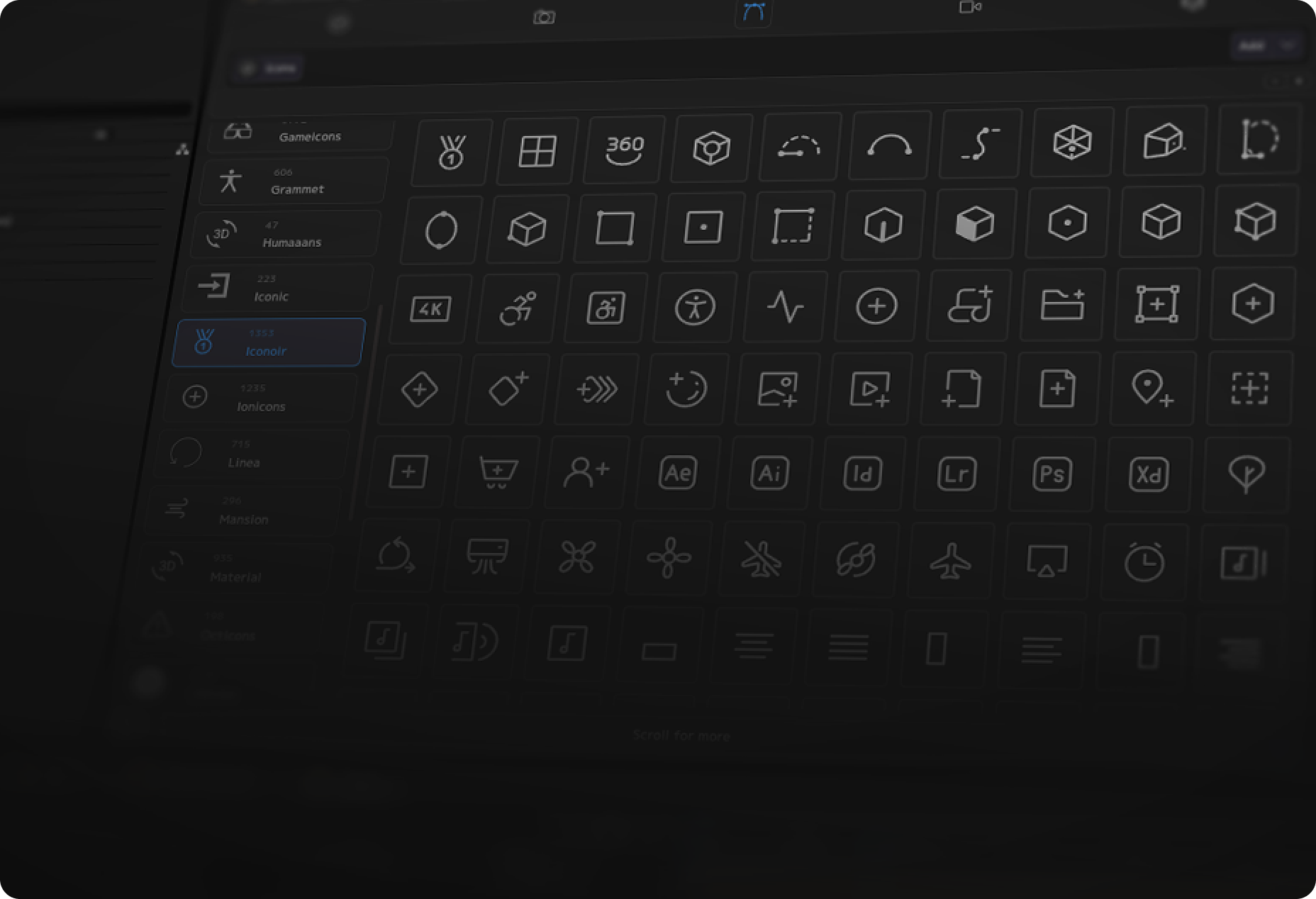NEW Explore the Pro Version
Big bad plugin
for brilliant edits.
Design and create stunning edits and videos at any
scale with BadEdit’s unique plugin, which helps you to
easily browse and apply presets.
Introducing
Introducing
Take your workflow to the next level with
our free plugin for After Effects & Premiere Pro.
Take your workflow to the next level with
our free plugin for After Effects & Premiere Pro.

The Ultimate Solution for Media Assets
Browse & Apply Breezily
Quickly find and import media assets
with ease directly into your timeline
Get a taste of premium-quality products with a free
bundle pack built into the plugin - ready to use
as soon as you install

Useful Tools for After Effects
All our products are built by professionals, packed with
trendy, smooth-running effects that drop right
into your timeline.

Huge Library of Free Presets
You'll find tutorials for every step and even if you get stuck,
we're right here to guide you through every part
of your editing journey.
The Ultimate Solution for Media Assets
Quickly find and import media assets
with ease directly into your timeline
Royalty-Free Icon Libraries
Explore and apply presets and media effortlessly with our
plugin, designed to make browsing more seamless andrt
enhance your creative workflow.
Huge Free Library of Essential Presets
Huge Free Library of Essential Presets
All the essential presets to create
and refine your next project.
All the essential presets to create
and refine your next project.
Quick-Start for Animation Process
Quick-Start for Animation Process
Professional motion tools to jump-start
and animate your next project.
Professional motion tools to jump-start
and animate your next project.

Wiggle
Explore and apply presets and media effortlessly with our plugin, designed to make browsing

Bounce
Save time with powerful tools that simplify tasks and streamline workflows in After Effects

Overshoot
Easily apply various presets with just a single click, thanks to our intuitive and dedicated browser

Spinner
Explore and apply presets and media effortlessly with our plugin, designed to make browsing

Flicker
Save time with powerful tools that simplify tasks and streamline workflows in After Effects

Fader
Easily apply various presets with just a single click, thanks to our intuitive and dedicated browser
High-Quality Sound Effects
High-Quality Sound Effects
Essential sound effects library curated by
creators to bring cinematic quality to your edits
Essential sound effects library curated by
creators to bring cinematic quality to your edits
Speed-Up Your Workflow
Speed-Up Your Workflow
Easily adjust the settings of project layers,
folders, compositions and more in bulk
Easily adjust the settings of project layers,
folders, compositions and more in bulk

Batch Renamer
Save time with powerful tools that simplify tasks and streamline workflows in After Effects

Comp Setter
Explore and apply presets and media effortlessly with our plugin, designed to make browsing seamless

Organise Project
Easily apply various presets with just a single click, thanks to our intuitive and dedicated browser

Wiggle
Property
The wiggle expression in After Effects adds random motion to properties like position, rotation, or scale.
Using wiggle(freq, amp), you control speed and intensity, creating natural, dynamic movement effortlessly.
It’s great for simulating handheld camera movement, flickering lights, or jittery text.
wiggle(3, 20) makes an object move randomly 3 times per second with a max displacement of 20 pixels.
For more control, link wiggle values to sliders or combine it with expressions like time or random() for more organic, customisable animations.
FAQ
FAQ
Frequently Asked Questions
Frequently Asked Questions
Which license do I need to purchase?
In this guide, we explain how to use the embed component in Framer to integrate sites, widgets, and scripts. The system uses a CAPTCHA test (Completely Automated Public Turing to tell Computers and Humans Apart). It operates in the background, so your site visitors aren’t bothered by typing random from an image.
- Add text to your project.
Open the properties panel on the right and select the font from the picker.
Go to the Custom tab.
Click Upload.
Choose the font file from your computer.
The font will now appear in the Custom tab.
Importing fonts from Figma
Custom fonts from Figma projects may default to Framer’s standard font because the original custom font isn’t available. To fix this, upload the custom font to your project in Framer. Then, select the text layers and reapply the font by choosing the newly uploaded custom font.
How does app management tool work?
In this guide, we explain how to use the embed component in Framer to integrate sites, widgets, and scripts. The system uses a CAPTCHA test (Completely Automated Public Turing to tell Computers and Humans Apart). It operates in the background, so your site visitors aren’t bothered by typing random from an image.
1.Add text to your project.
2. Open the properties panel on the right and select the font from the picker.
3. Go to the Custom tab.
4. Click Upload.
5. Choose the font file from your computer.
6. The font will now appear in the Custom tab.
Importing fonts from Figma
Custom fonts from Figma projects may default to Framer’s standard font because the original custom font isn’t available. To fix this, upload the custom font to your project in Framer. Then, select the text layers and reapply the font by choosing the newly uploaded custom font.
Can I export my website to HTML and self-host it?
In this guide, we explain how to use the embed component in Framer to integrate sites, widgets, and scripts. The system uses a CAPTCHA test (Completely Automated Public Turing to tell Computers and Humans Apart). It operates in the background, so your site visitors aren’t bothered by typing random from an image.
1.Add text to your project.
2. Open the properties panel on the right and select the font from the picker.
3. Go to the Custom tab.
4. Click Upload.
5. Choose the font file from your computer.
6. The font will now appear in the Custom tab.
Importing fonts from Figma
Custom fonts from Figma projects may default to Framer’s standard font because the original custom font isn’t available. To fix this, upload the custom font to your project in Framer. Then, select the text layers and reapply the font by choosing the newly uploaded custom font.
How to create flexible CMS detail pages
In this guide, we explain how to use the embed component in BadEdits to integrate sites, widgets, and scripts. The system uses a CAPTCHA test (Completely Automated Public Turing to tell Computers and Humans Apart). It operates in the background, so your site visitors aren’t bothered by typing random from an image.
How to add a custom class to an element
In this guide, we explain how to use the embed component in Framer to integrate sites, widgets, and scripts. The system uses a CAPTCHA test (Completely Automated Public Turing to tell Computers and Humans Apart). It operates in the background, so your site visitors aren’t bothered by typing random from an image.
1.Add text to your project.
2. Open the properties panel on the right and select the font from the picker.
3. Go to the Custom tab.
4. Click Upload.
5. Choose the font file from your computer.
6. The font will now appear in the Custom tab.
Importing fonts from Figma
Custom fonts from Figma projects may default to Framer’s standard font because the original custom font isn’t available. To fix this, upload the custom font to your project in Framer. Then, select the text layers and reapply the font by choosing the newly uploaded custom font.
How to choose the right font license for Framer
In this guide, we explain how to use the embed component in Framer to integrate sites, widgets, and scripts. The system uses a CAPTCHA test (Completely Automated Public Turing to tell Computers and Humans Apart). It operates in the background, so your site visitors aren’t bothered by typing random from an image.
1.Add text to your project.
2. Open the properties panel on the right and select the font from the picker.
3. Go to the Custom tab.
4. Click Upload.
5. Choose the font file from your computer.
6. The font will now appear in the Custom tab.
Importing fonts from Figma
Custom fonts from Figma projects may default to Framer’s standard font because the original custom font isn’t available. To fix this, upload the custom font to your project in Framer. Then, select the text layers and reapply the font by choosing the newly uploaded custom font.




